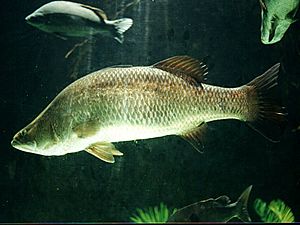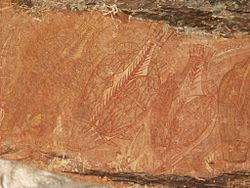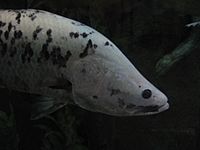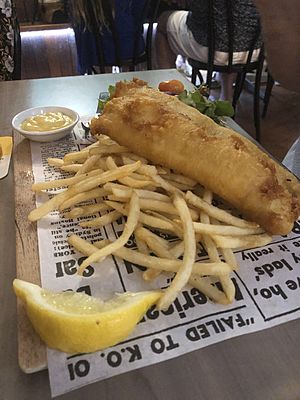Barramundi facts for kids
Quick facts for kids Barramundi |
|
|---|---|
 |
|
| Barramundi (in foreground) | |
| Conservation status | |
| Scientific classification | |
| Synonyms | |
|
The barramundi (Lates calcarifer), also called the Asian sea bass, is a type of fish that lives in both fresh and salt water. It belongs to the family Latidae. You can find this fish in many places, from South Asia all the way to Papua New Guinea and Northern Australia.
Contents
What's in a Name?
The name "barramundi" comes from an Australian Aboriginal language. It means "large-scaled river fish." This name was first used for different fish, like the Southern saratoga and the Gulf saratoga.
However, in the 1980s, people started using the name "barramundi" for Lates calcarifer to help sell it better. This made the fish much more famous! Scientists often call it the Asian seabass, but it's also known as the Australian seabass.
About the Barramundi
This fish has a long body and a big mouth. Its upper jaw goes past its eye. The edges of its gill cover are rough, and it has a small spine. Its scales are rough, like tiny combs.
The barramundi's body is flat from side to side. It has fins with both hard spines and soft rays. Its tail fin is flat and rounded.
Barramundi are popular for fishing in both fresh and salt water. They have large, shiny silver scales. Their color can change to be darker or lighter depending on where they live.
These fish can grow very big, up to about 1.8 meters (6 feet) long. However, it's rare to catch one that size. The heaviest barramundi ever caught weighed around 60 kg (132 lb). Most barramundi are about 0.6 to 1.2 meters (2 to 4 feet) long.
Barramundi live in coastal waters, river mouths (estuaries), lagoons, and rivers. They prefer clear or slightly cloudy water that is usually between 26 and 30°C (79 and 86°F). They don't travel very far, which means different groups of barramundi in Australia have become unique over time.
Life Story of a Barramundi
Young barramundi eat tiny water creatures called zooplankton. Adult barramundi eat crabs, shellfish, and smaller fish. Sometimes, they even eat other barramundi!
Barramundi can live in both fresh and salt water, but they like a specific temperature. They live in rivers and then swim down to estuaries and tidal flats to lay their eggs. Some barramundi populations even live only in the ocean if there's no fresh water nearby.
When the monsoon season starts, male barramundi swim downriver to meet the females. Females lay millions of eggs! The adult fish do not protect their eggs or the baby fish (fry). The young fish need slightly salty water to grow.
Most barramundi are born male. After at least one spawning season, they change into females. This means that the biggest barramundi you see are usually females.
Fishing for Fun
Barramundi are a favorite fish for anglers and sport-fishing fans. They are known for putting up a good fight! They are also very good at avoiding nets, so they are best caught with fishing lines and fishing lures.
In Australia, barramundi are put into freshwater lakes and dams for people to catch for fun. These "impoundment barramundi" are very popular for "catch and release" fishing. Some popular places to catch them include Lake Tinaroo, Lake Proserpine, Teemburra Dam, Lake Moondarra, Lake Awoonga, and Lake Monduran.
Catching and Farming Barramundi
Barramundi are important for commercial fishing. They are caught and farmed in many countries around the world. These include Australia, Singapore, Malaysia, India, Thailand, and the United States.
Australia's barramundi farming industry is quite big, producing over 4,000 tons each year. In Southeast Asia, even more barramundi are farmed, with over 30,000 tons produced annually.
When farmed, barramundi usually grow from small babies (50-100 mm long) to a good eating size (400-600 grams) in about 12 months. They can reach 3 kg (6.6 lb) in 18 to 24 months.
Barramundi as Pets
Young barramundi make popular aquarium fish. They can be very fun to watch, especially when they eat! However, they grow very fast. So, they need a large fish tank, at least 500 liters (132 gallons) or bigger.
In a tank, they can become quite friendly and might even eat from your hand. They are not aggressive, but they eat very quickly and suddenly. Because of this, you can't keep them with any other fish that are small enough for them to swallow.
Barramundi as Food
Barramundi has a mild taste and white, flaky meat. It can have different amounts of fat.
In Australia, people love barramundi so much that a lot of the fish eaten there is actually imported from other countries. This makes it harder for Australian fishers and farmers, who have higher costs. Labels now tell you where your barramundi comes from when you buy it in stores. However, restaurants don't always have to say where their barramundi comes from.
Barramundi in Different Cuisines
- Australian Cuisine:
Barramundi is a very popular fish in Australia. It's often served with chips, just like traditional fish and chips.
- Bengali Cuisine:
In Bengal, barramundi is called bhetki. It's a popular fish for celebrations like weddings. It can be cooked in many ways, like bhetki machher paturi (fish cooked in banana leaves) or fried with semolina. People who don't like fish with many bones often enjoy bhetki fillets because they have no bones. Fried bhetki fillets are a favorite dish called "fish fry."
- Goan Cuisine:
In Goa, barramundi is called chonak. It's often cooked with a special red spice paste called recheado or coated in semolina and fried. It's usually cut into thin slices. People eat it as a snack or with drinks or a main meal. It's one of the more expensive fish you can buy there.
- Thai Cuisine:
In Thailand, barramundi from fish farms are called pla kapong. It has become one of the most popular fish in Thai cuisine. It's often steamed with lime and garlic, or deep-fried, or stir-fried with lemongrass. You can see pla kapong in tanks at many Thai restaurants. Sometimes, menus might wrongly call this fish "snapper" or "sea bass."
- United States:
Barramundi is becoming more popular in the US. The Monterey Bay Aquarium has even said that barramundi farmed in the US and Vietnam are a "Best Choice" for sustainable seafood.
See also
 In Spanish: Barramundi para niños
In Spanish: Barramundi para niños





